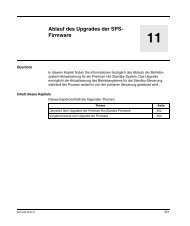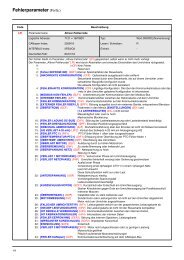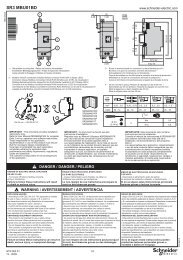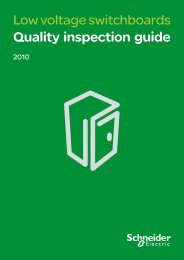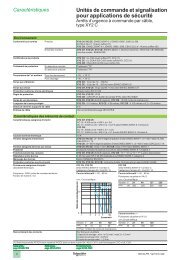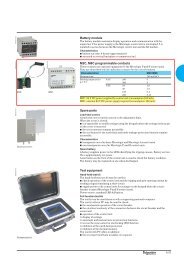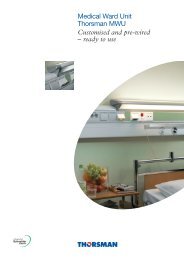Alternative Approach to Improving SAIDI and SAIFI - Schneider Electric
Alternative Approach to Improving SAIDI and SAIFI - Schneider Electric
Alternative Approach to Improving SAIDI and SAIFI - Schneider Electric
Create successful ePaper yourself
Turn your PDF publications into a flip-book with our unique Google optimized e-Paper software.
An <strong>Alternative</strong> <strong>Approach</strong><br />
<strong>to</strong> <strong>Improving</strong> <strong>SAIDI</strong><br />
<strong>and</strong> <strong>SAIFI</strong> Indica<strong>to</strong>rs<br />
Philippe Deschamps - <strong>Schneider</strong> <strong>Electric</strong> Industries - France<br />
Jean-Chris<strong>to</strong>phe Orsini - <strong>Schneider</strong> <strong>Electric</strong> Industries - France<br />
Kaare Seest Rasmussen - DONG Energy - Denmark
Summary<br />
Abstract ......................................................................................................p 1<br />
Introduction .................................................................................................p 2<br />
DONG Energy's network .............................................................................p 3<br />
The concept of a SACSe substation ............................................................p 4<br />
SACSe control unit architecture ...................................................................p 7<br />
F200C: Possible further enhancement .........................................................p 8<br />
Conclusion ..................................................................................................p 9<br />
C I R E D - 20th International Conference on <strong>Electric</strong>ity Distribution<br />
Prague, 8-11 June 2009
Abstract<br />
Under the pressure of regulating authorities, utilities are being challenged <strong>to</strong><br />
improve their <strong>SAIDI</strong> <strong>and</strong> <strong>SAIFI</strong> indica<strong>to</strong>rs. Usually, <strong>to</strong> reach this goal, more<br />
intelligence is put inside DMS, increasing at the same time the amount<br />
of data <strong>to</strong> be processed <strong>and</strong> the importance of communication in the<br />
network. An alternative way, discussed in this paper, consists of using local<br />
au<strong>to</strong>mation, allowing faster reactions, <strong>and</strong> therefore a drastic reduction of the<br />
number of cus<strong>to</strong>mers affected by permanent faults, without requiring heavy<br />
communication infrastructure. In addition, this paper introduces a further<br />
enhancement allowing a faster power res<strong>to</strong>ration for the remaining affected<br />
cus<strong>to</strong>mers.<br />
An <strong>Alternative</strong> <strong>Approach</strong> <strong>to</strong> <strong>Improving</strong> <strong>SAIDI</strong> <strong>and</strong> <strong>SAIFI</strong> Indica<strong>to</strong>rs<br />
C I R E D - 20th International Conference on <strong>Electric</strong>ity Distribution<br />
Prague, 8-11 8-11 June 2009<br />
Paper 0635 | 1
Introduction<br />
Challenged by the Danish authorities, DONG Energy has for a long time<br />
experimented with several methods <strong>to</strong> optimize network management <strong>and</strong><br />
particularly increase power availability. An important step was reached when<br />
it was decided <strong>to</strong> reduce the maximum time <strong>to</strong> reenergize a faulty location <strong>to</strong><br />
less than a minute <strong>to</strong> avoid the outage <strong>to</strong> be counted as a long one, that is<br />
degrading the <strong>SAIDI</strong> <strong>and</strong> <strong>SAIFI</strong> indexes.<br />
An <strong>Alternative</strong> <strong>Approach</strong> <strong>to</strong> <strong>Improving</strong> <strong>SAIDI</strong> <strong>and</strong> <strong>SAIFI</strong> Indica<strong>to</strong>rs<br />
C I R E D - 20th International Conference on <strong>Electric</strong>ity Distribution<br />
Prague, 8-11 8-11 June 2009<br />
Paper 0635 | 2
DONG Energy's network<br />
DONG Energy is a major DNO in Denmark, however this experience involves only one part of its<br />
network.<br />
FLA10-622<br />
FLA04<br />
3383<br />
4033<br />
FLA10-6202<br />
FLA10-3722<br />
FLA10-7007<br />
FLA10-3369<br />
2017<br />
FLA09-3024<br />
FLA09-5562<br />
4956<br />
2928<br />
2365<br />
5199<br />
Fig.1 - Typical feeder (neighbouring feeders in white)<br />
823<br />
3304<br />
3320<br />
2367<br />
The 10 kV grid in DONG Energy North, is a 100<br />
per cent underground radial network, with a high<br />
degree of access <strong>to</strong> neighbouring feeders for<br />
backup, as shown in Fig. 1.<br />
FLA03-4554<br />
FLA03-4553<br />
2366<br />
3568<br />
2726<br />
104<br />
FLA03-3972<br />
FLA03-3971<br />
FLA03-3970<br />
The grid is mainly urban <strong>and</strong> consists of<br />
approximately 7000 substations on 600 feeders.<br />
An <strong>Alternative</strong> <strong>Approach</strong> <strong>to</strong> <strong>Improving</strong> <strong>SAIDI</strong> <strong>and</strong> <strong>SAIFI</strong> Indica<strong>to</strong>rs<br />
C I R E D - 20th International Conference on <strong>Electric</strong>ity Distribution<br />
Prague, 8-11 8-11 June 2009<br />
Paper 0635 | 3<br />
4916<br />
4915<br />
FLA03-4524<br />
FLA03-4914<br />
FLA15-998
The concept of a SACSe substation<br />
First of all, let’s clarify the management of<br />
phase-<strong>to</strong>-phase <strong>and</strong> phase-<strong>to</strong>-earth faults in the<br />
DONG Energy network:<br />
• phase-<strong>to</strong>-phase faults: these cause the<br />
tripping of a breaker <strong>and</strong> therefore an outage<br />
which explains how SACSe limits the number of<br />
cus<strong>to</strong>mers affected<br />
• phase-<strong>to</strong>-earth faults: the network is<br />
Petersen-coil grounded, allowing temporary<br />
operation with single earth fault. However, SACSe<br />
provides an earth-fault localization information<br />
because a second earth fault would cause a<br />
tripping.<br />
SACSe means "Sectionalizing And Changeover<br />
System enhanced". The concept of SACSe<br />
described below is the latest evolution of the<br />
network, which has already seen significant<br />
improvement over the last 10 years.<br />
A first step was taken by deploying circuit breakers<br />
in the network [1].<br />
SACSe - Main principle<br />
First of all, in a given feeder, one or two substations<br />
are selected <strong>to</strong> support the au<strong>to</strong>mation. They are<br />
chosen because of their location: they divide the<br />
feeder in<strong>to</strong> two or three segments, each supplying<br />
roughly the same number of cus<strong>to</strong>mers. They are<br />
also chosen because of the ease of upgrading<br />
them. The principle of layout in the network of<br />
these substations is described in the ref [2].<br />
Second, a backup line coming from the neighbour<br />
feeder is connected <strong>to</strong> these strategic MV/LV<br />
substations <strong>to</strong> allow a backup supply if required<br />
(Fig. 2).<br />
Incoming/outgoing/backup<br />
MV/LV<br />
transformer<br />
Fig. 3 - Typical make-up of a switchgear in a SACSe MV/LV<br />
substation<br />
The goal is <strong>to</strong> put in one strategic MV/LV<br />
substation, a line circuit breaker intended <strong>to</strong> split<br />
the feeder in<strong>to</strong> 2 segments in order <strong>to</strong> minimize<br />
the number of cus<strong>to</strong>mers affected by a fault, if it<br />
happens on the downstream side. Time selectivity<br />
is used <strong>to</strong> prevent primary substation CB from<br />
tripping simultaneously. In some cases, there<br />
could be up <strong>to</strong> two line CBs on the feeder: in such<br />
a case they would use the same setting <strong>and</strong> trip<br />
simultaneously.<br />
The second concept is a step further. In case<br />
of a phase-<strong>to</strong>-phase fault upstream in the same<br />
substation, it allows the faulty segment <strong>to</strong> be<br />
au<strong>to</strong>matically isolated <strong>and</strong> the healthy ones <strong>to</strong> be<br />
au<strong>to</strong>matically resupplied. This process is based on<br />
local au<strong>to</strong>mation, allowing a fast reaction, <strong>and</strong> not<br />
needing any human intervention or communication<br />
infrastructure. The solution was developed in<br />
collaboration with <strong>Schneider</strong> <strong>Electric</strong>, which offers<br />
a wide range of products for network au<strong>to</strong>mation.<br />
HV/MV sub<br />
Feeder 1<br />
Feeder 2<br />
Feeder n<br />
Fig. 2 - Principle of a SACSe substation layout in DONG<br />
Energy’s network<br />
These substations are equipped with a fourfunction<br />
switchgear (Fig. 3):<br />
• 1 fuse switch or circuit breaker for the<br />
transformer protection. It can be forgotten since it<br />
has no role in the concept.<br />
• 2 circuit breakers <strong>and</strong> 1 switch distributed<br />
among the incoming, the outgoing, <strong>and</strong> the<br />
backup lines. There are two circuit breakers among<br />
the three <strong>to</strong> be sure that there will be at least one in<br />
the circuit in all network configuration cases.<br />
An <strong>Alternative</strong> <strong>Approach</strong> <strong>to</strong> <strong>Improving</strong> <strong>SAIDI</strong> <strong>and</strong> <strong>SAIFI</strong> Indica<strong>to</strong>rs<br />
Backup line<br />
MV/LV sub<br />
SACSe MV/LV sub<br />
C I R E D - 20th International Conference on <strong>Electric</strong>ity Distribution<br />
Prague, 8-11 8-11 June 2009<br />
Paper 0635 | 4
If a fault occurs downstream, the breaker opens<br />
instantaneously, isolating the downstream<br />
segment(s). The status of the switchgear is then<br />
sent <strong>to</strong> the SCADA. If a fault occurs upstream, the<br />
switchgear acts as an au<strong>to</strong> changeover (ACO):<br />
the circuit breaker will not trip, but the lack of<br />
voltage releases the au<strong>to</strong> changeover process,<br />
ordering the incoming <strong>to</strong> open <strong>and</strong> the backup<br />
<strong>to</strong> close, which supplies the healthy downstream<br />
segment. This is the general principle. Two cases<br />
are shown in Fig. 4. Since the breaker in the HV/<br />
MV substation is delayed <strong>and</strong> those in the SACSe<br />
are not, the breaker in the HV/MV sub will only trip<br />
when the fault is in the first segment<br />
(Fig. 4 - case 1).<br />
In a particular case (2 SACSe on the same feeder),<br />
a fault downstream in the second SACSe results<br />
in both SACSe circuit breakers tripping. In order<br />
<strong>to</strong> resupply the segment between the two SACSe<br />
circuit breakers, the downstream one will act as a<br />
Reverse Au<strong>to</strong> Changeover (RACO): based on the<br />
CB tripping information, it will keep the incoming<br />
closed, <strong>and</strong> order the backup <strong>to</strong> close, therefore<br />
resupplying the upstream segment<br />
(Fig. 5).<br />
Fig. 5 - ACO - principle of fault res<strong>to</strong>ration<br />
Trip<br />
Trip<br />
+<br />
reserve<br />
backup<br />
Fig. 4 - ACO - principle of fault res<strong>to</strong>ration<br />
In all cases, the time required <strong>to</strong> reconfigure is less<br />
than 20 seconds, saving au<strong>to</strong>matically up <strong>to</strong> 2/3 of<br />
the cus<strong>to</strong>mers normally affected by such a fault.<br />
In addition, several logic processes are embedded<br />
in the au<strong>to</strong>mation in order <strong>to</strong> avoid any improper<br />
action in certain cases:<br />
• once the ACO/RACO has operated, it is blocked<br />
until there is some human interaction from the<br />
control center <strong>to</strong> prevent further action in a nonst<strong>and</strong>ard<br />
network configuration<br />
• a logic process is in action <strong>to</strong> avoid any ACO<br />
<strong>and</strong>/or RACO action if the network is subject <strong>to</strong><br />
a global outage, from the transport for instance.<br />
This event is detected by moni<strong>to</strong>ring the voltage<br />
presence on the backup line. If an absence of<br />
voltage is observed on both incoming <strong>and</strong> backup<br />
lines, then no action is taken<br />
• in case of a frequency drop, a recovery process<br />
exists in the HV/MV substation <strong>and</strong> it, it reacts by<br />
switching off some feeders. So in this case, the<br />
ACO/RACO is inhibited <strong>to</strong> allow the load-shedding<br />
process <strong>to</strong> be prioritized.<br />
An <strong>Alternative</strong> <strong>Approach</strong> <strong>to</strong> <strong>Improving</strong> <strong>SAIDI</strong> <strong>and</strong> <strong>SAIFI</strong> Indica<strong>to</strong>rs<br />
Case 1 Case 2<br />
C I R E D - 20th International Conference on <strong>Electric</strong>ity Distribution<br />
Prague, 8-11 8-11 June 2009<br />
Paper 0635 | 5<br />
Trip<br />
Open<br />
+<br />
backup<br />
Trip<br />
Open<br />
+<br />
backup
Infrastructure<br />
Basically, the system does not require any means<br />
of communication <strong>to</strong> react properly <strong>and</strong> fulfil its<br />
purpose. In fact this is even an advantage in terms<br />
of security <strong>and</strong> reliability. But of course, it is linked<br />
with the SCADA <strong>to</strong> report the outage on the faulty<br />
segment, in order <strong>to</strong> res<strong>to</strong>re the power. In addition,<br />
it reports its status <strong>to</strong> the operating staff, as Danish<br />
regulations require the opera<strong>to</strong>r<br />
Earth fault<br />
As explained above, SACSe also integrates<br />
directional fault passage indica<strong>to</strong>rs (FPIs). These<br />
FPIs allow the staff <strong>to</strong> locate the fault in the field<br />
more accurately <strong>and</strong> faster, <strong>and</strong> therefore prevent a<br />
tripping due <strong>to</strong> a second fault.<br />
<strong>to</strong> know the real status of all switches <strong>and</strong><br />
breakers in the network all times. By these<br />
means, other information available in the MV/LV<br />
substation can also be transmitted. In this case,<br />
<strong>and</strong> thanks <strong>to</strong> good coverage of the area by GSM<br />
infrastructure, GPRS has been chosen <strong>to</strong> transfer<br />
data in a very economical way.<br />
All these features are embedded in a single box<br />
provided by <strong>Schneider</strong> <strong>Electric</strong>, which is described<br />
below.<br />
An <strong>Alternative</strong> <strong>Approach</strong> <strong>to</strong> <strong>Improving</strong> <strong>SAIDI</strong> <strong>and</strong> <strong>SAIFI</strong> Indica<strong>to</strong>rs<br />
C I R E D - 20th International Conference on <strong>Electric</strong>ity Distribution<br />
Prague, 8-11 8-11 June 2009<br />
Paper 0635 | 6
SACSe control unit architecture<br />
Functional description<br />
The unit integrates the following functions (Fig. 6):<br />
• phase-<strong>to</strong>-phase fault protection ensured by two<br />
protection relays, for the incoming/outgoing <strong>and</strong><br />
backup breakers<br />
• phase-<strong>to</strong>-earth fault detection ensured by two<br />
directional fault passage indica<strong>to</strong>rs on the same<br />
functions<br />
• voltage presence on incoming, outgoing, <strong>and</strong><br />
backup cables<br />
• au<strong>to</strong>mation ensuring the ACO/RACO logic<br />
• communication with the SCADA on the status of<br />
the substation<br />
• power supply with batteries <strong>to</strong> supply the unit<br />
under all conditions.<br />
In addition, LV <strong>and</strong> MV measurement features have<br />
been included in the unit <strong>to</strong> provide a much better<br />
knowledge of the substation <strong>and</strong> the network load.<br />
Design<br />
SACSe is designed as an industrial solution<br />
integrating existing or slightly modified products<br />
from the <strong>Schneider</strong> <strong>Electric</strong> Easergy offer:<br />
• relays from the SEPAM range<br />
• FPI for earth protection is based on the Flair<br />
range<br />
• au<strong>to</strong>mation is based on the Easergy T200 which<br />
includes peripheral functions such as backup/main<br />
power supply <strong>and</strong> modem.<br />
All these products were designed specifically<br />
for the network au<strong>to</strong>mation environment. As a<br />
consequence, they comply with the specificities<br />
of this application: harsh environment withst<strong>and</strong><br />
(temperature, EMC, electrical insulation -10 kV on<br />
mains, dust, humidity, etc.), allowing the high level<br />
Fig. 7 - SACSe<br />
control unit<br />
Phase<br />
I protection<br />
I<br />
Eart<br />
detection<br />
U<br />
Fig. 6 - General architecture of the SACSe system<br />
of robustness required by such an application,<br />
openness in terms of communication pro<strong>to</strong>cols,<br />
<strong>and</strong> a ready-<strong>to</strong>-use product <strong>to</strong> minimize the<br />
settings on-site during the installation. All these<br />
products are integrated in a single box (Fig. 7)<br />
in a way <strong>to</strong> make it easy <strong>to</strong> integrate in<strong>to</strong> DONG<br />
Energy's existing installed base. No assembling is<br />
needed on-site, just the mounting of one box, <strong>and</strong><br />
the connection of the sensors <strong>and</strong> the comm<strong>and</strong>s<br />
in the switchgear.<br />
In terms of size, the system is made <strong>to</strong> be<br />
mounted directly on the wall of the substation. The<br />
dimensions allow it <strong>to</strong> be used even in a compact<br />
substation with reduced volume available.<br />
Interfaces are designed <strong>to</strong> make installation<br />
simple <strong>and</strong> minimize the risk of mistakes by using<br />
prefabricated cables <strong>and</strong> connec<strong>to</strong>rs <strong>to</strong> link the<br />
unit with sensors.<br />
The box is equipped with a transparent window<br />
on the front door, allowing all indica<strong>to</strong>rs of the<br />
status of the system <strong>to</strong> be read locally. If needed,<br />
operating staff have access <strong>to</strong> the local operation<br />
by opening the front door.<br />
An <strong>Alternative</strong> <strong>Approach</strong> <strong>to</strong> <strong>Improving</strong> <strong>SAIDI</strong> <strong>and</strong> <strong>SAIFI</strong> Indica<strong>to</strong>rs<br />
C I R E D - 20th International Conference on <strong>Electric</strong>ity Distribution<br />
Prague, 8-11 8-11 June 2009<br />
Paper 0635 | 7<br />
U I<br />
ACO<br />
RACO<br />
logic<br />
Com<br />
Power<br />
supply
Thanks <strong>to</strong> the unit presented above, the <strong>SAIDI</strong><br />
index is drastically reduced, but ultimate quality<br />
requires some additional instrumentation of the<br />
network:<br />
• In case of a phase fault, only half (if 1 SACSe) or<br />
one third (of 2 SACSe) of the feeder cus<strong>to</strong>mers are<br />
affected by an outage more than one minute.<br />
However, the half or third of cus<strong>to</strong>mers in the faulty<br />
segment still need <strong>to</strong> get power back as soon as<br />
possible.<br />
• In case of an earth fault, the SACSe control<br />
unit can indicate whether the fault is upstream or<br />
downstream the SACSe substation. But a more<br />
accurate localization is required in order <strong>to</strong> allow<br />
faulty cable isolation without power interruption<br />
for any cus<strong>to</strong>mer.<br />
Of course, for obvious cost <strong>and</strong> complexity<br />
reasons, more than two SACSe substations on<br />
a feeder are not possible. Increasing the number<br />
of SACSe substations is therefore not a way <strong>to</strong><br />
achieve ultimate quality.<br />
This means a device allowing accurate localization<br />
of both phase faults <strong>and</strong> earth faults is needed<br />
in the other substations, both upstream <strong>and</strong><br />
downstream from the SACSe.<br />
Accurate localization would ideally mean knowing<br />
which cable between the two substations is faulty.<br />
<strong>Schneider</strong> <strong>Electric</strong> has recently launched a new<br />
communicating fault passage indica<strong>to</strong>r, the<br />
Flair 200C, combining in a single cost-effective<br />
product the phase-<strong>to</strong>-phase <strong>and</strong> phase-<strong>to</strong>-earth<br />
fault detection <strong>and</strong> the GPRS communication<br />
functions. This would suit the above purpose<br />
particularly well. It should be noted that this new<br />
Flair 200C embeds a new algorithm for detection<br />
of phase-<strong>to</strong>-earth faults on compensated networks<br />
not requiring voltage sensing. This allows the<br />
commissioning of such devices <strong>to</strong> be drastically<br />
simplified, especially for retrofit in existing<br />
substations, <strong>and</strong> it reduces the global cost.<br />
Additionally, the Flair 200C can optionally provide<br />
measurements, further increasing the knowledge<br />
of network load.<br />
An <strong>Alternative</strong> <strong>Approach</strong> <strong>to</strong> <strong>Improving</strong> <strong>SAIDI</strong> <strong>and</strong> <strong>SAIFI</strong> Indica<strong>to</strong>rs<br />
F200C: Possible further enhancement<br />
C I R E D - 20th International Conference on <strong>Electric</strong>ity Distribution<br />
Prague, 8-11 8-11 June 2009<br />
Paper 0635 | 8
Conclusion<br />
Increasing pressure on <strong>SAIDI</strong>/<strong>SAIFI</strong> improvement<br />
usually requires more performance from DMS,<br />
<strong>and</strong> at the same time the management of<br />
more <strong>and</strong> more information. A complementary<br />
solution involves the use of local au<strong>to</strong>mation<br />
able <strong>to</strong> perform simple actions quickly. By this<br />
means, when a fault occurs, a rough but fast<br />
reconfiguration is done while the operation is<br />
simplified.<br />
References<br />
The implementation of this requires a dedicated<br />
device <strong>to</strong> prevent complex commissioning from<br />
spoiling the solution, <strong>and</strong> therefore the Return On<br />
Investment.<br />
[1] Peter Vinter, Henrik Vikelgaard, 2005, "A novel approach <strong>to</strong> distribution grid au<strong>to</strong>mation at NESA A/S",<br />
CIRED Conference 18th international conference on electricity distribution.<br />
Session 3.<br />
[2] Kåre Seest Rasmussen, 2009, "A real case of self healing distribution network", CIRED Conference 20 th international<br />
conference on electricity distribution.<br />
Session 3.<br />
An <strong>Alternative</strong> <strong>Approach</strong> <strong>to</strong> <strong>Improving</strong> <strong>SAIDI</strong> <strong>and</strong> <strong>SAIFI</strong> Indica<strong>to</strong>rs<br />
C I R E D - 20th International Conference on <strong>Electric</strong>ity Distribution<br />
Prague, 8-11 8-11 June 2009<br />
Paper 0635 | 9
Reserved.<br />
Rights All<br />
<strong>Schneider</strong> <strong>Electric</strong> Industries SAS<br />
35, rue Joseph Monier<br />
<strong>Electric</strong>.<br />
CS 30323<br />
F- 92506 Rueil Malmaison Cedex<br />
<strong>Schneider</strong><br />
RCS Nanterre 954 503 439<br />
This document has been<br />
Capital social 896 313 776<br />
printed on ecological paper 2011<br />
www.schneider-electric.com ©<br />
998-5592<br />
09-2011



